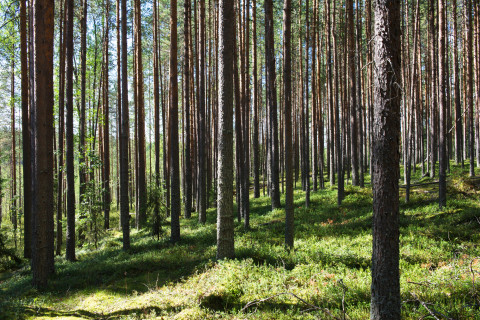A comprehensive review of the impacts of variable retention forestry and restoration methods in Fennoscandia — a shared view of an international research group on supporting forest biodiversity
Finnish, Swedish and Russian researchers highlight the ecological effects of forestry in Fennoscandia in five review articles published in the journal Ecological Processes. The summarized research suggests that the amount of dead trees in commercial forests is not sufficient for the species requiring decaying wood. To improve the situation, the researchers propose retaining considerably more dead trees and old trees in felling, increasing the number of retention trees and prescribed burning, and improving the forest certification system.
Dead trees should be retained more accurately in felling and more should be produced
In their study, Research Professor Matti Koivula and Research Scientist Ilkka Vanha-Majamaa from the Natural Resources Institute Finland (Luke) reviewed the results of 22 Fennoscandian experimental set-ups on the effects of felling. The average volume of dead trees in commercial forests is only a few cubic metres, and the results show that especially coarse woody debris in advanced stages of decay is susceptible to destruction in connection with forest regeneration.
According to Koivula and Vanha-Majamaa, Finland could take inspiration from the many measures implemented in Swedish commercial forests and leave more wood in forests in connection with felling, as in Russia in the past, to ensure sufficient decaying wood in the future as well. They propose both short-term and long-term responses to halt the loss of biodiversity in forests.
“All dead trees— excluding concentrations at high risk of European spruce bark beetle infestations (more than 10 cubic metres of damaged, weakened or fresh windfalls of spruce trees per hectare) — should be retained in felling and more should be produced, for example, by creating artificial snags, as Sweden has done for a long time and now also Finland to some extent. Artificially created snags benefit endangered species, although their species composition differ slightly from the species in naturally died trees”, Koivula says.
The summarized studies suggest that all deadwood concentrations, apart from those at high risk for bark beetle infestations, should be retained in connection with forest management activities. The destruction of individual dead trees in felling and harvesting of deadwood as energy wood should also be avoided. According to Professor Lena Gustafsson from the Swedish University of Agricultural Sciences (SLU), in addition to retaining decaying wood, biodiversity can be supported cost-effectively by not harvesting defective or economically insignificant trees, saving valuable habitats from felling, and concentrating biodiversity efforts. This would mean, for example, larger but less densely concentrated retention patches.
PEFC forest certification standard needs to be developed to better reflect biodiversity
A large number of studies show that the retention tree requirements in Finland (currently ten trees per hectare, minimum DBH ≥ 10 cm), which are mainly based on the Program for the Endorsement of Forest Certification (PEFC) forest certification standard, are too low to maintain forest biodiversity. Thus, PEFC does not meet the ecological objectives set for it.
“Despite this, the ecological criteria of the certification system have been weakened in the updating rounds of the PEFC standard”, says Timo Kuuluvainen, Lecturer in silviculture at the University of Helsinki.
On average, the total volume of living retention trees in harvested sites is less than three cubic metres per hectare. The reviewed research shows that such low levels of retention trees are not enough to increase, or even to maintain, the volume of dead trees in commercial forests. In Sweden, as much as 11% of the forest area is not treated in connection with regeneration felling. In Finland, the corresponding figure has generally been less than 3% per year.
According to the raw material statistics from Luke, up to half a million cubic metres of forest chips used by heat and power plants have been produced from large-sized timber, a large proportion of which is from dead trees.
“This amount is larger than the volume of live retention trees left in clear cutting in non-industrial private forests each year, 0.3 million cubic metres”, says Petri Keto-Tokoi, Lecturer in forest ecology at Tampere University of Applied Sciences (TAMK).
This is despite the fact that the PEFC criterion on energy wood clearly obliges forest owners not to damage large decayed trees. Furthermore, in harvesting operations carried out on unfrozen soil, more deadwood is destroyed than in winter felling. If mild winters become more common, as seems to be the case at least in southern parts of the Fennoscandian countries, the authors anticipate that felling activities will further drive the destruction of decayed trees and loss of biodiversity.
Based on the summarized results, the minimum amount of retention should be between 5% and 10% of the total volume of the growing stock, and the minimum diameter of living retention trees should be re-established at 20 cm.
Prescribed burning should be increased
Although increasing prescribed burning in order to maintain diversity has been recommended for a long time, the size of the area burnt has diminished. According to the authors, prescribed burning of stands with large number of retention trees should be re-introduced in state-owned commercial forests, and the support scheme for private forestry should be reformed to encourage forest owners to carry out prescribed burning in connection with their forest regeneration activities.
“The ongoing updates of certification systems could also help to promote prescribed burning”, says Henrik Lindberg, Principal Research Scientist at Häme University of Applied Sciences (HAMK).
Pekka Punttila, Senior Researcher from the Finnish Environment Institute (SYKE), is concerned about the decline in habitats and species dependent on wildfires, and hopes that more conservation areas could be established in wildfire areas:
“It would also be important to increase restoration and nature and forest management-based burning, as has been proposed in recent assessments of threatened species and habitat types”, Punttila says.
Partial felling in north-west Russia since 1910
In Russia, clear cutting started as early as the 1910s. Compared with the Finnish clear-cutting practice, the Russian method differed in that, on average, 10% to 40% of the growing stock was left unharvested, typically in the wettest and most inaccessible forests.
“In practice, Russia implemented exactly the kind of measures that scientists are now proposing to safeguard biodiversity in Finland and Sweden”, says Ekaterina Shorohova, Senior Specialist from Luke.
These Russian forests are now more diversely structured than Finnish forests, contain more decaying wood, and are more diverse in their species, but they have been subject to less experimental research than elsewhere in the Fennoscandian region.
The ‘incomplete’ clear cuts continued in Russia until the 1960s, and the areas treated would now provide a good opportunity to study the long-term effects of retention felling.
“The last of these forests are becoming old enough for regeneration felling, and the big question in Russia is how they should be treated in the future. If they were to follow the Fennoscandian model, the results can be seen in the current state of declined biodiversity in the forests in Finland and Sweden”, says Shorohova.
Recommendations for maintaining and restoring forest biodiversity in connection with felling
- All dead trees should be retained, the destruction of individual decayed trees should be avoided, and concentrations of dead trees should be preserved, as long as these actions do not significantly increase the risk of European spruce bark beetle infestations.
- Harvesting dead trees for energy wood should be avoided.
- Trees that are technically defective or otherwise economically insignificant should not be harvested.
- The number of large, old retention trees should be increased.
- The size of the retention tree groups should be increased, and they should be placed in biodiversity-critical areas, such as concentrations of decaying wood and mire depressions.
- Retention trees should be selected and retained in connection with early and later thinnings, as this would enable better selection of the tree species and individuals that are best suitable as retention trees. This can be done by leaving such trees in thickets, which stand out as untreated patches in later thinning, and/or by updating them as point objects in the forest stand data.
- The number of artificially created snags should be increased to produce new decaying wood, including in the case of intermediate felling. The artificially created snags should include different sizes and types of trees.
- The minimum number of retention trees should be between 5% and 10% of the total growing stock.
- Valuable habitats, such as mire depressions, which may not be specified in the forest stand data, should be left uncut.
- Prescribed burning should be re-introduced in state-owned commercial forests, and burning of stands with large number of retention trees should be increased, as should burning for restoration as well as nature and forest management-based burning.
- More conservation areas should be established in wildfire areas.
- The support scheme for private forestry should be reformed to encourage forest owners to carry out prescribed burning.
- Forest certification schemes should be developed to take biodiversity better into account. For example, in the PEFC standard, the minimum diameter of retention trees should be re-established at 20 cm.
Further information:
Ilkka Vanha-Majamaa, Research Scientist, Luke, tel. +358 (0)29 532 2532, ilkka.vanha-majamaa (a) luke.fi
Matti Koivula, Research Professor, Luke, tel. +358 (0)29 532 2251, matti.koivula (a) luke.fi
Ekaterina Shorohova, Senior Specialist, Luke, tel. +358 (0)29 532 2172, ekaterina.shorokhova (a) luke.fi
Henrik Lindberg, Principal Research Scientist, HAMK, tel. 358 (0)50 574 5380, henrik.lindberg (a) hamk.fi
Timo Kuuluvainen, Lecturer in silviculture, University of Helsinki, tel. +358 (0)29 415 8116, timo.kuuluvainen (a) helsinki.fi
Pekka Punttila, Senior Researcher, SYKE, tel. +358 (0)29 525 1523, pekka.punttila (a) ymparisto.fi
Petri Keto-Tokoi, Lecturer in forest ecology, TAMK, tel. +358 (0)40 548 0034, petri.keto-tokoi (a) tamk.fi
Lena Gustafsson, Professor (emerita), SLU, tel. +46 18672747, +46 70 3022747, lena.gustafsson (a) slu.se
Mats Hannerz, CEO, Silvinformation AB, tel. +46 70 528 85 54, mats.hannerz (a) silvinformation.se
Jan Weslien, Professor, Skogforsk, tel. +46 (70) 698 59 29, jan-olov.weslien (a) skogforsk.se
Aleksandr Kryshen, Director, Forest Research Institute of Karelian Research Centre RAS, +79214513324, kryshen (a) krc.karelia.ru
Sergey Sinkevich, Leading Researcher, Forest Research Institute of Karelian Research Centre RAS, +7(8142)768160, sergei.sinkevich (a) krc.karelia.ru
The five articles are part of a thematic issue dealing with alternative forest management methods for clear cutting around the world and, in particular with regard to Fennoscandia, the established retention tree practices and their ecological impact. These methods are apparently being dealt for the first time in this magnitude, says Vanha-Majamaa, one of the editors of the thematic issue. The authors of the articles concerning the Fennoscandia region include researchers from Luke, Helsinki University and the University of Eastern Finland, SYKE, Häme and Tampere Universities of Applied Sciences in Finland, SLU, Skogforsk and Silvinformation in Sweden, and the Petrozavodsk Forest Research Institute and the Saint-Petersburg State Forest Technical University in Russia.
Thematic issue published in Ecological Processes: Ecological Perspectives on Variable Retention Forestry.
Editorial: Guillermo J. Martinez-Pastur, Ilkka Vanha-Majamaa, Jerry F. Franklin: Ecological Perspectives on Variable Retention Forestry
Articles:
Matti Koivula, Ilkka Vanha-Majamaa: Experimental evidence on biodiversity impacts of variable retention forestry, prescribed burning, and deadwood manipulation in Fennoscandia
Lena Gustafsson, Mats Hannerz, Matti Koivula, Ekaterina Shorohova, Ilkka Vanha-Majamaa, Jan Weslien: Research on retention forestry in Northern Europe
Henrik Lindberg, Pekka Punttila, Ilkka Vanha-Majamaa: The challenge of combining variable retention and prescribed burning in Finland
Timo Kuuluvainen, Henrik Lindberg, Ilkka Vanha-Majamaa, Petri Keto-Tokoi, Pekka Punttila: Low-level retention forestry, certification, and biodiversity: case Finland
Ekaterina Shorohova, Sergey Sinkevich, Aleksandr Kryshen, Ilkka Vanha-Majamaa: Variable retention forestry in European boreal forests in Russia


